3 What Are the Main Concepts in Anthropology?

Main Concepts in Anthropology: Culture & Evolution
Anthropological research is predicated on two main concepts: 1) culture, and 2) evolutionary theory. In this chapter, you will learn about the anthropological culture concept and the basic tenets of evolutionary theory and how it impacts anthropological research.
Culture is widely used term. In the popular vernacular, culture often refers to the arts. A person who is cultured has knowledge of and is a patron of the arts. Pop culture refers to what is trendy, current, or hip. Within anthropology, these things are simply aspects of ‘culture.’ To understand the anthropological culture concept, we need to think broader and holistically.
Culture is a concept that has been defined many ways since anthropology emerged as an academic discipline. E.B. Tylor, the father of the science of anthropology (Whitney 2006, 2234), equated culture with civilization and defined it as,
…that complex whole which includes knowledge, belief, art, morals, law, custom, and any other capabilities and habits acquired by man as a member of society (Tylor 1920, 1).
Tylor’s was only the first attempt within anthropology to define culture. His definition was criticized as being ambiguous in defining the subject and useless in the development of cultural theory (Goldstein 1957). Since then, many anthropologists have tried to define culture. In 1952, Alfred Kroeber and Clyde Kluckhohn, two distinguished 20th-century anthropologists, compiled a list of 161 different definitions of culture (“Culture” 2018). Part of the problem with defining culture is that the word is used to describe both a general concept describing a system of adaptation and describing specific groups of people. In fact, most anthropologists today think of the term “culture” in two ways: 1) culture (singular) which is a general concept describing behavioral elements, and 2) cultures (plural), which are specific human groups sharing a set of behaviors—the group members are bound together. Anthropologists differentiate the latter from the former by using “a culture” when referring to a bounded group and “culture” when referring to the general concept.
Culture: The Culture Concept
Culture is comprised of several elements. These elements are found in all groups. The first element is that culture is learned. When babies are born, they are not born with cultural knowledge—it is not biologically inherent. Cultural knowledge is acquired over a lifetime. We may think of our behaviors as ‘natural’ because we begin learning the behaviors from the moment we are born. We are enculturated into the “cultural rules and cultural logic” of the group we are born into. Enculturation is the process of learning those rules and logic and happens to every human being (and many other animals) on earth. Because of enculturation, some behaviors are in our consciousness for so long that we cease to remember that we once had to learn them, hence, they are “natural” to us. This does not dismiss the fact that they are learned behaviors.
Does this mean that every behavior is cultural in nature? No. In fact, it is one of the jobs of the anthropologist to determine which behaviors are biological in nature and which are cultural. Once biological reasons for a behavior are ruled out then there must be a cultural explanation for that behavior. It can be confusing because it is easy to confuse a biological reaction with behavior. For instance, burping is a biological reaction to having too much air in our stomach. What we do when we burp is cultural in nature. In some cultures, you are expected to cover your mouth when you burp and apologize to anyone around you for releasing bodily gas. In other cultures, burping is a sign that you enjoyed a meal—no need to apologize; in fact, it is considered a compliment to the cook. When anthropologists describe cultural behaviors, they will usually include biological behaviors necessary for the completion of the cultural behavior. From raising an eyebrow to running around, cultural behaviors generally have a biological component.
The second element is that culture is symbolic. Symbols are an object, idea, image, figure, or character that represent something else (Welsch et.al. 2017). Language is one of the most symbolic characteristics of a culture. It is one of the obvious things that signifies to which cultural group we belong. Some symbols may mean the same thing across various cultures, e.g., for many Christians, the clover is a symbol of the holy trinity (father, son, holy ghost) and God’s grace. However, there are symbols which mean different things in different cultures. Take the flag of the United States. To people in the United States, it generally is not just a symbol of the nation, but it symbolizes patriotism, freedom, and democracy. In countries where the United States has been in a prolonged military conflict, the US flag might symbolize military aggression, capitalism, and oppression.
The third element is that culture is shared. Some cultural norms, which are socially acceptable patterns and rules of behavior, are shared by small groups of people such as occupations or hobbyists. Other cultural norms are shared by large groups of people, e.g., nations. No matter the size of the group, the members decide which behaviors are appropriate and which are inappropriate. There are referred to as cultural constructions, “the meanings, concepts, and practices that people build out of their shared and collective experiences” (Welsch et.al. 2017, 36).
Fourthly, anthropologists have determined that culture is holistic or an integrated system. If you recall from chapter 1, you learned that culture is a system of interrelated parts. From kinship patterns to religious beliefs to subsistence strategies, all the social institutions, which are “organized sets of social relationships that link people together in a structured way in a particular society” (Welsch et.al. 2017, 42), are interconnected. Social institutions include such things as economics (subsistence strategies fall within economics), expressive culture (including religion and the arts), political systems, health care, kinship, family, and marriage. Anthropological research has demonstrated how these social systems are interconnected. Let us look briefly at the Ariaal, a pastoral people who live in northern Kenya, for an example.
The Ariaal practice a diversified system of animal husbandry, raising camel, cattle, sheep, and goats. They split up their herds, pasturing them in different places, a practice that ensures the herds’ survivability against disease and drought. The herds are used not only as resources in and of themselves, but their grazing encourages the growth of seasonal vegetation that the Ariaal can use for trade. While sheep and goats along with camel milk are primarily used for food, cattle are used as bride price, a practice whereby the groom’s family provides the bride’s family with some sort of material compensation for the loss of a productive family member. A hidden benefit of bride price is that movement of cattle from one herd to another helps to maintain the biological diversity of the herd and distributes wealth among the people.
Since the Ariaal divide their herds and pasture them across the landscape, their settlements are widely dispersed. This would make it difficult to maintain social cohesion, but the Ariaal developed the practice of age-sets to offset the loss of social cohesion. An age-set is a group of individuals of roughly the same age that are given specific duties within the society at large. In the case of the Ariaal, there are three age-sets for each sex: for females the age-sets are girl, adolescent, married, and for males the sets are boy, warrior, elder. Each age-set has a specific set of clothes, diet, duties, and socializing rules, e.g., adolescent girls are not allowed to associate with any males, including their fathers, while warriors are not allowed to associate with women, including their mother. This practice not only ensures that labor is distributed among the members of the group but serves as a form of population control because pubescent/young adult males and females are separated until it is time for them to marry. These are a few examples of the holistic nature of a few Ariaal social institutions.
The fifth element of culture is integration. Culture is integrated with our daily experiences. Welsch et.al (2017, 35) state that “how we relate to the world seems natural to us, transparent, obvious, inevitable, and necessary.” This leads to expectations about how things are supposed to be done. For instance, in the United States, it is deemed ‘natural’ that babies sleep in their own beds in their own rooms. In a society that values independence, parents think that sleeping with their babies creates emotional dependence. Conversely, Abagusii parents in Kenya think that it is ‘natural’ to sleep with their infants. They want to encourage emotional dependence because their culture values reliance on one another.
As mentioned in chapter 1, culture is a blueprint for living, providing guidelines for socially appropriate standards of behavior. This is not to say that culture determines all our actions, which is an idea called cultural determinism. There is variation of responses within any given culture. This variation provides a pool of behaviors from which cultures can pull to respond to new circumstances, which leads us to the final element of culture—culture changes.
Culture changes in response to mutable environments both cultural and natural. It is a dynamic process.
Social groups are not uniform or homogeneous because not everybody interprets the events of everyday life in the same way, nor do they blindly act out scripts already laid out for them to perform. Cultural processes are emergent, fluid, and marked by creativity, uncertainty, differing individual meaning, and social conflict (Park 2014, 35).

The process of culture change can be rife with conflict because cultures are conservative, meaning that cultures do not like to change. Traditions, habits, those behaviors that seem ‘natural’ are difficult to change. Take, for instance, the women’s suffragette movement. In the United States, the movement began with abolitionism. Drawing on ideals espoused by Frederick Douglass in his fight against slavery, suffragists staged boycotts, public assemblies, hunger strikes, and petitions to advocate for women’s right to vote. Many were physically attacked, and many were imprisoned. From 1832, when Maria Stewart made the first public call for women’s rights, until 1920 when the 19th Amendment was ratified, many Americans embedded in a patriarchal culture resisted the movement for women’s rights (Marino n.d.)
To recap, culture is:
- learned,
- symbolic,
- shared,
- holistic,
- integrated, and
- it changes.
Biological Aspects of Culture
As previously mentioned, cultural behaviors have biological aspects, and it all starts with the brain from which all cultural behavior begins.
Paul MacLean (1913-2007), a psychobiologist formerly with the National Institute of Mental Health, proposed the human brain was three brains in one. He called this the triune brain, referring to three evolutionary stages of the mammalian brain. MacLean stated that these three brains were interconnected in the modern brain but developed at different times in human growth cycle contributing to our ability to think in ever complex ways (Park 2014).
The reptilian brain, located at the base of the brain, is the oldest, most primitive part of the brain. It responsible for self-preservation functions, e.g., involuntary functions such as breathing and digestion, and survival behaviors such as reproduction and territoriality. Our fight or flight response is also controlled by the reptilian, or R-complex, brain. The limbic system is in the center of the brain. It is the second oldest part of the brain and controls emotions, from rage to love. Our sense of smell and basic sexual functioning are also controlled by the limbic system. It is connected to the neocortex, which is necessary to process emotions. The neocortex is at the top of our brain, over the limbic system. It is responsible for our ability to reason, learn, and problem solve. It is the highest level of cognition. Vision, hearing, and the foundation of intelligence and memory are contained within the neocortex, which can contain massive amounts of stored information (“Your Triune Brain” n.d.).
The three brains interact, operating together to create a feedback loop of basic survival behavior, emotional responses, and high order thinking. They provide the “basis for the complex abilities of consciousness, reasoning, and, eventually, culture” (Park 2014, 72). What we experience is called upon to solve problems, make up stories, and create this thing we call culture.
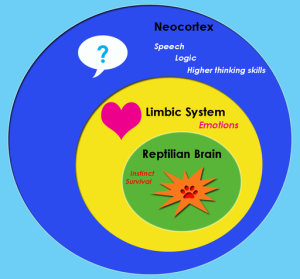
Evolutionary Theory
Since Darwin published his major treatise, On the Origin of Species by Natural Selection, in 1859, science and the public have been influenced by evolutionary theory. Darwin’s ideas were tested, retested, and expanded upon over the subsequent decades. As his theory challenged the prevailing ideology of the 19th-century, debate ensued within and outside of the sciences. While debate about evolution still occurs outside of the sciences, within the biological sciences, scientists accept evolutionary theory. Debate within the biological sciences about evolutionary theory now revolves around the specifics of how evolution occurs.
Evolutionary theory is important to anthropology it helps us to understand how humans came to be and where we fit into nature. Evolutionary theory explains the similarities and differences between human beings across the globe.
A Short History on the Development of Evolutionary Theory
Darwin did not develop his theory in a vacuum. Drawing from Aristotle to contemporaries such as Charles Lyell, Darwin built upon existing knowledge and added his own findings to generate his theory of evolution by natural selection. His ideas challenged the prevailing thoughts in
Europe and the United States on natural history and biology, sparking significant change in not only the scientific zeitgeist but the popular zeitgeist.
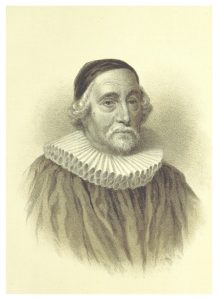
Some of the ideas that Darwin challenged were influenced by the Tanakh or Hebrew Bible and its Christian counterpart, the Old Testament in the Bible. One of these ideas was the fixity of species. This idea held that all living things were created by a divine being and were immutable, or unchanging. Another idea from these scriptures was the age of the earth. In 1650, Archbishop James Ussher (1581-1656) used historical texts and passages from the Bible outlining who begat who to calculate that earth was about 6,000 years old. In fact, he was quite specific and claimed earth was created on Sunday, October 23, 4004 BC of the Julien calendar (September 21, 4004 BC on the Gregorian calendar). Ussher was not the only person who calculated the age of earth using the same basic data. Sextus Julius Africanus (ca. 160-ca. 240), a Libyan-born intellectual, calculated the creation to 5499 BC (Azuonye 2008), one of the oldest dates, and Helwigius calculated the creation to 3836 BC, one of the youngest dates (Jones 2019). The idea that earth was relatively young was deeply entrenched in Judeo-Christian culture.
Questions about the fixity of species began as fossils of extinct animals were unearthed. By the late 1700s, scientists were trying to explain why extinction occurred if creation was perfect. Some suggested that the fossils were not of extinct species but of species living in unexplored places on earth. Others suggested that the fossils were of species that had ‘transmuted’ into other species. Still others claimed that that the fossils were not evidence of extinct species at all. It was the emerging field of comparative anatomy that supported the idea that fossils represented once-living species. Even so, scientists of the age pushed to explain extinction within a biblical context (Bowler 2013).
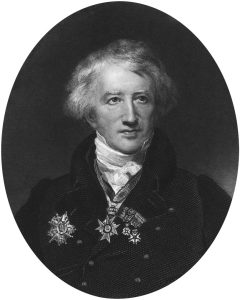
Georges Cuvier (1769-1832) was the preeminent comparative anatomist of his time and developed catastrophe theory to explain extinction within the biblical context. Cuvier claimed that geological catastrophes, such as floods and earthquakes, were responsible for most extinctions. Only such a massive geological catastrophe could wipe out entire species at the same time. And one such catastrophe was detailed in the Bible, Noah’s flood, so the theory did not challenge Cuvier’s own deeply held Christian beliefs. Catastrophe theory was challenged by the geological principle of uniformitarianism. First proposed by James Hutton (1726-1797) and formalized by Charles Lyell (1797-1875), the principle of uniformitarianism suggests that change is slow and gradual over great amounts of time. Lyell equated extinction with natural geological processes such as erosion and postulated that it too happened gradually over time (Bowler 2013).
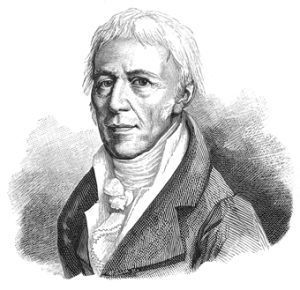
Scientists in Europe and the United States who attempted to explain species change outside of the context of the Judeo-Christian context were often excommunicated and shunned. Jean Baptiste Lamarck (1744-1829), a French biologist, was excoriated by his contemporaries after he proposed the first comprehensive biological theory of evolution. In 1809, Lamarck proposed that “environmental changes cause a change in an organism’s needs, which lead to change in behavior” (Robinson 2016, 4). He claimed that the change in behavior could then be passed down to the organism’s offspring, a principle called the inheritance of acquired characteristics. Lamarck thought that over time organisms became more complex and perfectly suited to their environments. New, simple species were formed through spontaneous generation, a concept that claims life comes from nonliving matter (Robinson 2016). Lamarck’s ideas were ridiculed at the time, and we know now that he was incorrect, but his ideas about the importance of the environment would influence Darwin.
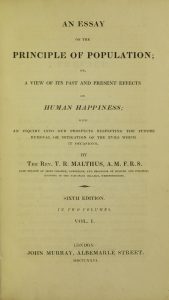
Darwin stated that he was particularly influenced by Thomas Malthus’ (English political economist, 1755-1834) “Essay on the Principle of Population,” 1798. In this essay, Malthus describes how increases in food production will be surpassed by population growth, creating misery among human populations (Lannay 2013). Darwin drew on the situation described by Malthus in his explanation of natural selection.
Darwin’s Theory Charles Darwin
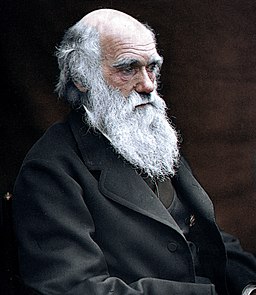
Darwin was born on February 12, 1809, in Shrewsbury, England. His father, Robert, and grandfather, Erasmus, were both physicians. His mother, Susannah, was a part of the Wedgwood family, famous even today for their fine china. Erasmus Darwin is remembered for his work Zoonomia, which attempts to explain the natural world using evolutionary principles (Mayr 2000). Clearly, Darwin was introduced to current intellectual thought about evolution when he was young (Darwin 1887).
Darwin grew up with a love of the natural world. Darwin himself tells us that early on he developed a love of travel and collecting things, including minerals and insects:
With respect to science, I continued collecting minerals with much zeal, but quite unscientifically—all that I cared about was a new-named mineral, and I hardly attempted to classify them. I must have observed insects with some little care, for when ten years old (1819) I went for three weeks to Plas Edwards on the sea-coast in Wales, I was very much interested and surprised at seeing a large black and scarlet Hemipterous insect, many moths (Zygæna), and a Cicindela which are not found in Shropshire. I almost made up my mind to begin collecting all the insects which I could find dead, for on consulting my sister I concluded that it was not right to kill insects for the sake of making a collection. From reading White’s ‘Selborne,’ I took much pleasure in watching the habits of birds, and even made notes on the subject. In my simplicity I remember wondering why every gentleman did not become an ornithologist (Darwin 1887: 34-35).
Darwin carried this love of the natural world to the University of Edinburgh, where he was introduced to the work of Cuvier, Lamarck, and Saint-Hilaire (Young 2007), and subsequently, the University of Cambridge. At Edinburgh, Darwin studied medicine, but when it became apparent that the young Darwin had no interest in medicine, his father sent him to study theology at Cambridge. It was at Cambridge that Darwin’s love of natural history flourished. He studied and worked with noted botanist J. S. Henslow, scientific generalist, William Whewell, and geologist, Adam Sedgwick, all of whom were influential in his intellectual development, although Henslow would be the most critical individual in Darwin’s post-college life (Bowler 1992, Mayr 1991, Young 2007). While at Cambridge, Darwin became an avid collector of beetles. This activity helped him become familiar with comparative anatomy,
The pretty Panagaus crux-major was a treasure in those days, and here at Down I saw a beetle running across a walk, and on picking it up instantly perceived that it differed slightly from P. crux-major, and it turned out to be P. quadripunctatus, which is only a variety or closely allied species, differing from it very slightly in outline (Darwin 1887:51),
a methodology that would be critical to the development of his evolutionary theory.
After graduating from Cambridge, Henslow helped Darwin secure a position aboard the H.M.S. Beagle as the ship’s naturalist. He almost did not make the trip as his father was against it, but his uncle, Josiah Wedgwood, convinced Darwin’s father to let him go on the voyage (Eldredge 2005). The Beagle, under the captaincy of Robert Fitzroy, left England on December 27, 1831, with the goal of charting the waters of South America (Bowler 1992, Futuyma 1986). While on the Beagle, Darwin, who was still an orthodox member of the Church of England (Futuyma 1986), made numerous observations that would eventually lead him to develop his theory of evolution by natural selection.
Darwin married his cousin, Emma Wedgwood, in 1839. By 1842, the Darwins moved from London to Downe in Kent so their children could grow up in the country and for Darwin’s health. In his later years, Darwin was plagued with ill health. While we do not know exactly from what he suffered, the symptoms suggest a malfunctioning of the autonomous nervous system (Mayr 1991).
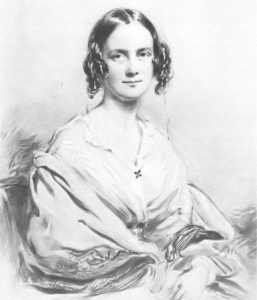
The Beagle Voyage
Optional: To read some of Darwin’s journal entries for the voyage, check out The Beagle Voyage or for a complete collection, see Journal of Researches.
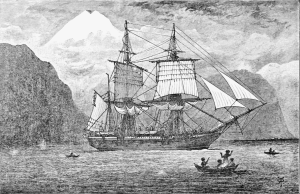
During the five years Darwin was on board the HMS Beagle, he read such scientific works as Charles Lyell’s Principles of Geology and made observations that eventually led him to question his belief in the fixity of species. He collected fossils, rocks, plants, and animals, many of which were shipped back to England where eventually specialists such as the ornithologist John Gould examined the specimens. Darwin’s discovery of a new species of the rhea living in the same area as the already known rhea raised questions about perfect adaptation…if it were true, why would there be two species of rhea in the same area? However, it was the Beagle’s stop in the Galápagos Islands that would be most important for the later development of his theory.
In the Galápagos, Darwin studied birds, iguanas, and tortoises. The natives of the Galápagos showed Darwin how to determine which island the tortoises came from based on the shape of their shells. After learning this, he returned to the birds he had collected and sorted them by island. This gave Darwin, “…an unrivalled [sic] opportunity to study the effects of geographical isolation in the production of new species” (Bowler 1992: 300). It would be the Galápagos birds, specifically the mockingbirds, that would lead Darwin to his ideas about natural selection (learn more about the mockingbirds).
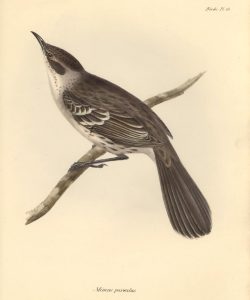
After the Beagle
Upon his return to England in October 1836, Darwin plunged himself into the scientific community of London. He had worked hard while on the Beagle so that he would not have to become a clergyman.
As far as I can judge of myself, I worked to the utmost during the voyage from the mere pleasure of investigation, and from my strong desire to add a few facts to the great mass of facts in Natural Science. But I was also ambitious to take a fair place among scientific men–whether more ambitious or less so than most of my fellow-workers, I can form no opinion (Charles Darwin quoted in Eldredge 2005: 27).
John Henslow and Charles Lyell had made Darwin well known in scientific circles while he was still at sea, so he readily became active in the Geological Society (Bowler 1992, Eldredge 2005) and the Athenaeum Club, a gentleman’s club that served as a meeting place for those of an intellectual bent (Eldredge 2005).
One of the first things Darwin did on his return was to organize and ship his collections to various specialists. Ornithologist John Gould quickly examined Darwin’s collection of birds, informing him that the mockingbirds in the collection were in fact different species of mockingbirds, some from the various Galápagos Islands and some from the South American mainland. Darwin theorized that this could only be explained if the island birds’ antecedents had found their way from the mainland to the islands. Once there, the descendants were gradually modified until they became new species (Young 2007: 108). Here we find Darwin’s coherent thoughts on the role geographic isolation has in speciation, or the creation of new species. By March 1837, Darwin had rejected the idea of the fixity of species and creation by design and accepted the idea of evolution and the role of geographic isolation in speciation (Futuyma 1986, Mayr 1991).
In July 1837, Darwin opened his first notebook, ‘Transmutation of Species,’ which was code for evolution during this period of history. In this notebook, Darwin explored ideas about reproduction and variation and the nature of species. By the time he concluded this notebook, Darwin had laid out his ideas on common descent and branching evolution. What he still didn’t know at this point was how it all occurred (Young 2007).
A year later, Darwin began his studies of artificial selection. His second notebook outlined his thoughts on variation and inheritance and their relation to adaptation (Young 2007). Darwin’s studies of artificial selection helped him understand how a natural mechanism might work (Bowler 1992). Breeders at the time talked about something akin to natural selection but only in the context of how it kept species and varieties “true to type” (Young 2007: 112). When Darwin read Thomas Malthus’s work, “An Essay on the Principle of Population,” in 1838, the concepts Malthus outlined on exponential population growth and competition among members of a population for a limited food supply provided the crucial piece that was missing. Darwin realized that considering competition among members of a population, variations of traits that allowed one member to have an advantage over another member would be preserved. He further concluded that disadvantageous variations would die out (Young 2007). Darwin now understood how it all occurred for all of nature, including humans.
As soon as I had become, in the year 1837 or 1838, convinced that species are mutable productions, I could not avoid the belief that man must come from under the same law (Darwin quoted in Eldredge 2005: 29.).
We know this concept as natural selection.
In 1842, Darwin outlined his ideas on evolution by natural selection, expanding further in an 1844 essay that was to be published only upon the event of his premature death. Bowler (1992) suggests Darwin did not publish at this time for two reasons: 1) the social climate–there was quite a bit of debate over Lamarck’s theory of evolution and Robert Chambers’ Vestiges of the Natural History of Creation that discussed evolution as part of a divine plan, and 2) he could not explain why the fossil record showed “…that many families had been subject to a constant trend towards increasing levels of specialization” (Bowler 1992: 304). The answer to this question would come a decade later when Darwin figured out that specialization provided an advantage even if the environment was stable because it cut down on competition for resources (Bowler 1992). During his time at Downe, Darwin used the scientific method to build his case for evolution by natural selection, particularly in his work with pigeons (Young 2007).
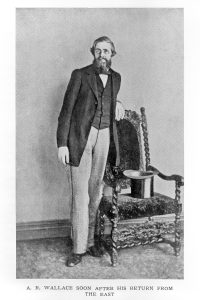
Darwin began to write his ‘Big Species’ book in 1856. He first published his ideas in 1858 after receiving a manuscript from Alfred Russel Wallace who outlined his own ideas on natural selection, which coincided with Darwin’s. At the urging of close friends in the scientific community, Darwin quickly put together a paper based on his 1844 essay that was presented by Charles Lyell and Joseph Hooker at the Linnean Society on July 1, 1858, along with Wallace’s manuscript. Darwin then set to work on putting together an abstract of his book, which was published in 1859. This abstract, On the Origin of Species by Natural Selection, sold out in one day (Futuyma 1986, Mayr 1991, Young 2007). It was “the book that shook the world” (Mayr 1991: 7).
After the publication of Origin, Darwin’s work focused on expanding on ideas that were touched on in the abstract, but not completely described. His other contributions to biology include The Variation of Animals and Plants under Domestication (1868), The Descent of Man and Selection in Relation to Sex (1871), The Expression of the Emotions in Man and Animals (1872), Insectivorous Plants (1875), The Effects of Cross- and Fertilization in the Vegetable Kingdom (1876), The Different Forms of Flowers on Plants of the Same Species (1877), The Power of Movement in Plants (1880 with Sir Francis Darwin), and The Formation of Vegetable Mold, through the Action of Worms, with Observations on Their Habits (1881).
Darwin died in 1882, but his work continued to be reviewed and oftentimes vilified by philosophers, theologians, scientists. etc. Darwin had several friends that supported his work both before and after his death, and while most scientists of the time came to support Darwin’s proposal about common descent, few adhered to his concept of natural selection (Mayr 1991). It would not be until the 1920s when a fundamental change occurred in the thinking about organisms that the true genius of Darwin’s work would be recognized on a broader scale (Futuyma 1986).
Darwin’s contribution is summed up nicely by Douglas Futuyma (1986:6):
Darwin was the first to marshal on so grand a scale the evidence of the first thesis [i.e., descent with modification from a common ancestor], the historical reality of evolution by drawing on all relevant sources of information: the fossil record, the geographic distribution of species, comparative anatomy and embryology, and the modification of domesticated organisms.
Mayr (1992) states that Darwin was unique among scientists of his day because he was not only a great naturalist and biologist but was a great theoretician and experimenter. It was these differences that allowed him to make links across fields and develop his comprehensive, complex theor(ies) of evolution.
20th-Century Evolutionary Theory: The Modern Synthesis
The Modern Synthesis incorporates data from multiple scientific disciplines, including biology, the natural sciences, genetics, paleontology, and paleoanthropology. While the basis for evolutionary theory was established by the beginning of the twentieth-century, debate continued as to whether natural selection or mutation was more important in evolution. In the 1930s, these two points of views came together to form the basis of the modern synthesis. Ronald A. Fisher (1890-1962), J.B.S. Haldane (1892-1964), and Sewall Wright (1889-1988) developed mathematical models that became the foundation of population genetics, which studies the frequency of alleles, genotypes, and phenotypes in populations (Miller 2011: 321).

However, it was Theodosius Dobzhansky (1900-1975) that married theoretical modeling and empirical research in his seminal work, Genetics and the Origin of Species (1937) and signals the start of the Modern Synthesis (Artmann 2006). Biologist Ernst Mayr (1904-2005) was another major contributor to the development of the modern synthesis. His work on the isolating mechanisms of speciation led to new insight into the evolution of new species. Mayr’s Systematics and the Origin of Species (1942) is one of the key works of the Modern Synthesis.
How Evolution Works
Basic Genetic Principles
Since our biological traits are encoded in our genes, it is important to know some basic genetic principles to understand how evolution works.
Genes, segments of deoxyribonucleic acid (DNA), code for proteins which are the basic units of our biological traits. It is the variation in genes that are passed to offspring that provide the means for biological change. DNA is comprised of several basic chemical units: sugar (specifically a deoxyribose), a phosphate group, and nucleotide bases.
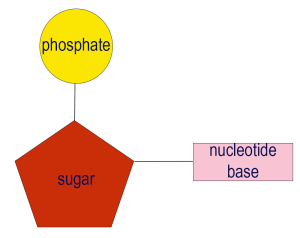
The nucleotide bases include adenine (A), thymine (T), cytosine (C), and guanine (G). A sugar, a phosphate group, and a single nucleotide base combine to form a nucleotide. Sugars and phosphate groups link up to create a strong phosphate backbone for the DNA. The chain that is created is one strand of DNA. The strand is connected to a second strand through the nucleotide bases. These bases bond together to form a complementary base pair: adenine and thymine bond together and cytosine and guanine bond together. Together, the two strands of DNA create the double helix structure first described by James Watson (1928-) and Francis Crick (1916-2004) in 1953. You can learn more about the discovery of the structure of DNA here (optional).
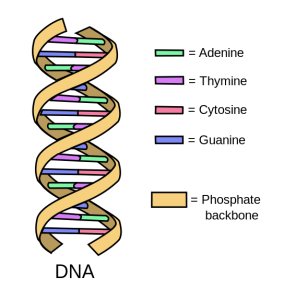
DNA has two functions: 1) to replicate itself during cell division and 2) direct the process of protein synthesis. DNA replicates itself during cell division: mitosis, which is when a somatic or body cell makes a copy of itself, and meiosis, which is when a sex cell (egg or sperm) divides. Errors during the replication process are called mutations. A mutation is a random change in the genetic coding and is the only new source of genetic material. Mutations that occur during meiosis are hereditary, which can impact the genetic makeup of subsequent generations; therefore, they can have quite an evolutionary impact. Mutations that occur during mitosis only impact an individual and may have an evolutionary impact if the mutation somehow impedes that individual’s ability to reproduce. Many mutations do not have detrimental effects to the individual, but some do. If the mutations are extreme, pregnancy often results in spontaneous abortion (miscarriage). However, mutations provide a necessary pool of genetic variation in a population. Mutations may have no known cause. These are called spontaneous mutations. Mutations caused by environmental factors are called induced mutations. If you would like to learn more about mutations, check out this short article from Sciencing (optional).
The second function of DNA is to direct the process of protein synthesis (click here to view an interactive graphic illustrating protein synthesis). This is a critical function since all the organic structures of the body are made of proteins. A protein is a string of small molecules called amino acids. There are twenty different amino acids which combine in various ways to form a polypeptide chain. The polypeptide chain folds in a certain way to produce a protein. The shape of the protein determines what it does in the cell (Brody n.d.). The protein is basically a gene.
As mentioned previously, genes code for proteins, or our biological traits. Before cell division can take place, our DNA separates into x-shaped chromosomes. Chromosomes are structures that contain “a single, linear molecule of DNA with its own set of genes” (What Are Chromosomes 2016). Each chromosome consists of two chromatids, referred to as sister chromatids. The chromatids join at the centromere. The location of the centromere helps to identify the chromosome.
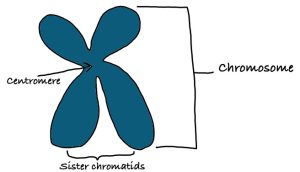
The number of chromosomes that form varies by species. Humans have 23 pairs of chromosomes. Each chromosome holds multiple genes. For instance, human chromosome 1, the largest chromosome, has between 2,000 to 2,100 genes, while the Y chromosome contains between 50 to 60 genes (“Chromosomes & mtDNA” 2020). The location of a gene on a chromosome is called the locus. Genes come in alternate forms or variants, which are called alleles. To clarify, if a gene equates to Jell-O, then the alleles equate to the different flavors of Jell-O that are available. To put it in biological terms, there is a gene that codes for ear wax and it has two forms (alleles): sticky or dry. Whether you have dry or sticky ear wax, depends on which alleles you inherited from your parents. You get one allele from each parent (that is when meiosis works properly).

These alleles may be the same, making them homozygous alleles, or different, or heterozygous alleles. Alleles are either dominant or recessive. For a dominant trait to be displayed, you only need one copy of the dominant allele. For a recessive trait to be displayed, you need to have two copies of the recessive allele. Returning to ear wax, if a person has sticky ear wax, then they could have two dominant alleles or one dominant allele and one recessive allele. If a person has dry ear wax, then they must have two copies of the recessive allele. Which allele you get from your parent is random. These principles of inheritance were first described by Gregor Mendel (1822-1884) in 1866 but were largely ignored by the scientific community until 1900 when his work was rediscovered by biologists (Robinson 2018).
What does this have to do with evolution? Everything. Traits that are inherited are the key to the evolutionary process.
Evolution: A Two Step Process
Emerging from the work of scientists of the Modern Synthesis, we know that evolution is a two-step process (Miller 2011: 85):
- The production and redistribution of variation, and
- Natural selection acts on variation resulting in differential reproduction among individuals in a population or a group of individuals from which mates are usually found. Sometimes this is referred to as a breeding population.
The production and redistribution of variation occurs through several genetic mechanisms, sometimes referred to as the forces of evolution. One of these mechanisms, you have already learned about—mutation. As mentioned previously, mutation is the only way new genetic material is made. It is estimated that each human has at least 60 mutations (Wolchover 2011). It is these mutations that provide new genetic variation with the gene pool. A gene pool is defined as all the alleles within a breeding population (Park 2014).
Variation within the gene pool is also affected by genetic drift, gene flow, recombination, and natural selection all of which are also genetic mechanisms of evolution (Welsch et.al. 2017). Recombination, or crossing over, occurs during meiosis when genetic material is exchanged between homologous chromosomes, which are pairs of chromosomes that are similar, e.g., we get a chromosome 1 from our father and a chromosome 1 from our mother. Note in the graphic below how the chromosomes morph from a solid color to multi-colored. This indicates that the chromosomes have exchanged genetic material, creating a new variation of genetic material (Speer 2003).
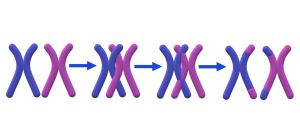
Gene flow is the exchange of genetic material between populations (Miller 2011). For humans, gene flow generally occurs when people move from one location to another. It should also be noted that migration does not always result in gene flow. For gene flow to occur interbreeding must happen. Human populations have exchanged genetic materials for millennia, helping to explain why there is only one human species.
Gene flow effects evolution in a couple of important ways (Evolution 101, 2015):
- With the introduction and reintroduction of genes to a population its genetic variation is increased, and
- The movement of genetic material can make distant populations genetically like one another, which reduces the chance of speciation.

Genetic drift is the “…chance variation in allele frequency in small populations” (Gould 2006, 1036). This can happen in a couple of ways: founder effect and bottleneck effect (or population bottleneck). Founder effect can occur if a small group separates from its parent group and settles elsewhere. Geographic isolation and endogamous marriage (human marriage pattern where mates are chosen from within a specific group, narrowing the gene pool) or mating practices restrict the gene pool, resulting in a lack of variation in comparison to the original parent population. If an allele is rare in the parent population, the small breeding population of the new group creates an environment whereby the rare allele can become common.
There are numerous examples of the founder effect among human populations. These include,
- Huntington’s Disease in Afrikaner populations in South Africa and among Venezuelans living near Lake Maracaibo,
- Prevalence of O blood type in Native Americans
- Ellis-van-Creveld syndrome (polydactyly) in Amish communities, and
- The Blue People of Kentucky (learn more about the Blue People).
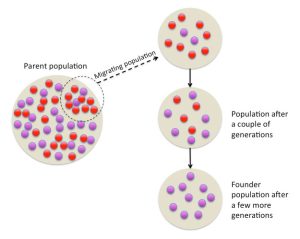
Bottleneck effect occurs when a population is drastically reduced in size due to some disaster, such as a natural disaster, habitat destruction, or disease, leaving the surviving population with different allele frequencies as the original population. Four human population bottlenecks, all related to climatic events, have been identified. The most severe occurred about 70,000 years ago when a super volcano erupted in Sumatra. It is estimated that only 5000 females survived in Africa (Ambrose 2003).
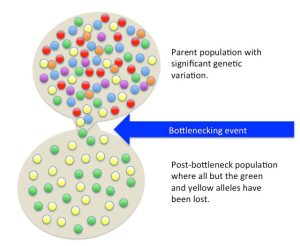
Once variation is produced in some combination of the above processes, natural selection goes to work, causing differential reproduction (changing allele frequencies) in populations related to environmental conditions. Darwin proposed that, “…individuals with advantageous characteristics…survive in higher numbers and produce more offspring than members of a population lacking advantageous characteristics” (Larsen 2008: 96). This is referred to as differential reproduction or fitness. Specifically, fitness is defined by the traits that confer an advantage to an individual allowing that individual to reproduce at a greater frequency than another individual. It could be something like beak shape that allows a bird to exploit resources better than other birds (think Darwin’s finches) or the color of wings that either hide or expose the peppered moth to predators (watch https://youtu.be/sVVldxxbWig for the full explanation) or a coloring, like the plumage of a male peacock, that attracts mates (this is referred to as sexual selection, which is a special case of natural selection referring to an individual’s ability to attract and copulate with a mate) that lead to differential reproduction.
Over time, these processes may result in evolutionary change, i.e., speciation. Shifts in allele frequency are called adaptation. In phrasing it this way, it sounds like natural selection works consciously, but it does not. Natural selection is a process that is mindless and mechanistic. Perfection and progress are not goals. It can only act on those variants that are present in a population.
As a result of the Modern Synthesis, a new definition of evolution emerged in the 20th-century: changing allele frequencies within a population from one generation to the next is the definition of evolution; specifically, this is microevolution.
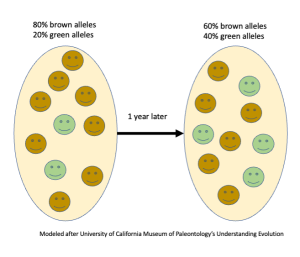
Macroevolution is change that occurs after many generations (hundreds or thousands); in other words, speciation. Speciation is “…the process by which a new species evolves from an earlier species” (Jurmain et al 2013: 105). “Macroevolution encompasses the grandest trends and transformation in evolution, such as the origin of mammals and the radiation of flowering plants” (Evolution 101, 2015). Macroevolutionary events are reconstructed using data from living organisms, geology, and fossils. These are generally represented in a graphic form called a phylogenetic tree (pictured below). Phylogenetic trees are a visual representation of proposed evolutionary relationships. They help researchers organize data. To learn more about phylogenetic trees check out Reading a Phylogenetic Tree.
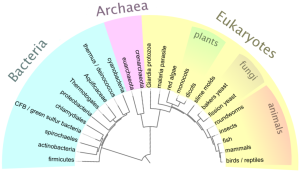
Species and Speciation
Mayr proposed the most referenced definition of species (1942; quoted in Provine 2004), “Species are a group of actually or potentially interbreeding natural populations, which are reproductively isolated from other such groups.” This definition is often referred to as the biological species concept. A key factor is that a species actually or potentially breeds in nature. However, this definition can be difficult to apply. Organisms that reproduce asexually or organisms that form hybrids, such as carrion crows and hooded crows, sometimes interbreed—are they one species or two species?). Furthermore, the biological species concept falls apart when applied to the fossil record, as it is impossible for scientists to observe the breeding behaviors of extinct organisms. Because of this, fossil species are called paleospecies and can cover long periods of time. Paleontologists and paleoanthropologists use comparative analysis with contemporary species that are closely related to determine whether variation seen in fossil specimens is intraspecific (differences within a species due to age and sex) or interspecific (differences due to reproductive isolation). It is important to remember that the species or paleospecies name is a classificatory tool used in the sciences. It helps scientists organize information and communicate more easily with one another.
The Extended Evolutionary Synthesis
The key idea behind the extended evolutionary synthesis is that organisms are not simply robots programmed by their genes, but also constructed during the developmental process of life itself. They also do not necessarily “fit” into natural environments but can shape those environments or coevolve along with them (Welsch et.al. 2017, 73).
In more recent decades, research in anthropology, genomics, developmental biology, ecology, and epigenetics suggest that evolution is affected by more than genetics. Non-genetic mechanisms of evolution such as developmental bias, plasticity, niche construction, and extra-genetic inheritance can impact how organisms adapt and change (Welsch et.al. 2017). “The [extended evolutionary synthesis] does not replace traditional thinking, but rather can be deployed alongside it to stimulate research in evolutionary biology” (“What Is the Extended Evolutionary Synthesis?” n.d.)
Developmental bias is the idea that not all variation is random. Some traits develop more easily and frequently due to the function of the developmental processes that occur during the lifetime (Welsch et.al. 2017, 73).
Plasticity may be the first step in evolution. It is a form of developmental bias whereby the form of an organism changes during its lifetime in response to environmental conditions. The change occurs and then mutation or selection of the genes causes the trait to become fixed (Welsch et.al. 2017, 74).
Organisms can alter their environments, for instance, elephants knock down trees to eat the leaves more easily, which helps to disperse seeds. It also helps plants to get more sunlight and the fallen trees can become homes to smaller organisms. This reshaping of the environment, or niche construction, may bias selection processes (Welsch et.al. 2017, 74).
Learned behaviors may affect evolution by impacting the reproductive success of individuals. Epigenetic factors may also impact evolution by chemically changing how DNA expresses itself, impacting such things as fertility and disease resistance (Welsch et.al. 2017, 74).
The extended evolutionary synthesis is a recent proposition and not without debate. If you would like to learn more about this advanced topic, visit the Extended Evolutionary Synthesis Integrated Research web site.
References
Ambrose, Stanley and Matilde Parente. 2018. “Population Bottleneck.” In Genetics, 2nd ed., 251-256. Vol. 3. Farmington Hills, MI: Gale. Accessed March 15, 2022. https://link.gale.com/apps/doc/CX2491300208/GVRL?u=wash_main&sid=bookmark-GVRL&xid=8c2951ef.
Azuonye, Chukwuma. 2008. “Africanus, Sextus Julius (ca. 160-ca. 240).” In Encyclopedia of the Africa Diaspora: Origins, Experiences, and Culture, edited by Carole Boyce Davies, 58-59. Vol. 1. Santa Barbara, CA: ABC-CLIO. Accessed March 14, 2022. https://link.gale.com/apps/doc/CX2444300032/GVRL?u=wash_main&sid=bookmark-GVRL&xid=b3af5e36.
Bowler, Peter J. 1994. The Environmental Sciences. New York, NY: W.W. Norton & Company, Inc.
Bowler, Peter J. 2013. “Georges Cuvier and the Discovery of Extinction.” In Grzimek’s Animal Life Encyclopedia: Extinction,” edited by Norman MacLeod, J. David Archibald, and Phillip S. Levin, 35-42. Vol. 1. Detroit, MI: Gale. Accessed March 14, 2022. https://link.gale.com/apps/doc/CX4020900012/GVRL?u=wash_main&sid=bookmark-GVRL&xid=6e67b1ae.
Brody, Lawrence C. n.d. “Amino Acids.” National Human Genome Research Institute. Accessed March 15, 2022. https://www.genome.gov/genetics-glossary/Amino-Acids.
“Chromosomes & mtDNA.” 2020. MedlinePlus. Accessed March 15, 2022. https://medlineplus.gov/genetics/chromosome/.
“Culture.” 2018. In The SAGE Encyclopedia of Lifespan Human Development, edited by Marc H. Bornstein, 502-506. Vol. 2. Thousand Oaks, CA: SAGE Reference. Accessed March 7, 2022. https://link.gale.com/apps/doc/CX7423500190/GVRL?u=wash_main&sid=bookmark-GVRL&xid=ec250085.
Darwin, Francis, editor. 1887. The Life and Letters of Charles Darwin. London: John Murray.
Eldredge, Niles. 2005. Darwin: Discovering the Tree of Life. New York, NY: W. W. Norton & Company.
“Evolution 101.” n.d. University of California Museum of Paleontology. Accessed May 12, 2015. http://evolution.berkeley.edu/evolibrary/article/evo_01.
Faulkner, Danny R. 2016. “Comments on Ussher’s Date of Creation.” Answers Research Journal 9: 163-169. Accessed March 14, 2022. https://answersresearchjournal.org/comments-usshers-date-of-creation/.
Futuyma, Douglas J. 1986 Evolutionary Biology, 2nd edition. Sunderland, MA: Sinauer Associates, Inc.
Goldstein, Leon J. 1957. “On Defining Culture.” American Anthropologist 59: 1075-1081. Accessed March 7, 2022. https://anthrosource.onlinelibrary.wiley.com/doi/pdf/10.1525/aa.1957.59.6.02a00110.
Hayden, T. 2009. “What Charles Darwin Didn’t Know.” Smithsonian (February). Accessed October 15, 2010. http://www.smithsonianmag.com/science-nature/What-Darwin-Didnt-Know.html?c=y&page=1.
Jones, Floyd Nolen, 2019. The Chronology of the Old Testament: A Return to Basics. Green Forest, AR: Master Books. Accessed March 14, 2022. https://www.floydnolenjonesministries.com/files/131144963.pdf.
Jurmain, Robert, Lynn Kilgore, Wenda Travathan. 2013. Essentials of Physical Anthropology. 4th ed. Belmont, CA: Wadsworth, Cengage Learning.
Lannay, Robert. 2013. “Malthus, Thomas R.” In Theory in Social and Cultural Anthropology, edited by R. Jon McGee and Richard L. Warms, 511-512. Vol. 2. Thousand Oaks, CA: SAGE Reference. Accessed March 14, 2022. https://link.gale.com/apps/doc/CX3737500181/GVRL?u=wash_main&sid=bookmark-GVRL&xid=5b7cb6ba.
Larsen, Clark Spencer. 2008. Our Origins: Discovering Physical Anthropology. New York, NY: W. W. Norton & Company, Inc.
Marino, Katherine M. n.d. “The International History of the US Suffrage Movement.” Accessed March 14, 2022. https://www.nps.gov/articles/the-internationalist-history-of-the-us-suffrage-movement.htm.
Mayr, Ernst. 1991. One Long Argument: Charles Darwin and the Genesis of Modern Evolutionary Thought. Cambridge, MA: Harvard University Press.
Mayr, Ernst. 2000. “Darwin’s Influence on Modern Thought.” Scientific American 283(1): 78-83.
Park, Michael Alan. 2014. Introducing Anthropology: An Integrated Approach, 6th edition.
Provine, William B. 2004. “Ernst Mayr: Genetics and Speciation.” Genetics 167(3): 1041-1046.
Robinson, Richard. 2016. “Lamarck, Jean-Baptiste.” In Biology, edited by Melissa Sue Hill, 4-5. Vol. 3. Farmington Hills, MI: Macmillan Reference USA. Accessed March 14, 2022. https://link.gale.com/apps/doc/CX3629800245/GVRL?u=wash_main&sid=bookmark-GVRL&xid=c5840867.
Robinson, Richard. 2018. “Mendel, Gregor.” In Genetics, 2nd ed., 51-54. Vol. 3. Farmington Hills, MI: Gale. Accessed March 15, 2022. https://link.gale.com/apps/doc/CX2491300165/GVRL?u=wash_main&sid=bookmark-GVRL&xid=d52ff35d.
Saneda, Tori. 2015. “Anthropological Culture Concept.” Accessed March 8, 2022. https://wikieducator.org/Cultural_Anthropology/Anth_Perspective/Key_Concepts#Anthropological_Culture_Concept.
Saneda, Tori and Michelle Field. 2015. “Darwinian Evolution.” Accessed March 14, 2022. https://wikieducator.org/Biological_Anthropology/Unit_1:_Evolutionary_Theory/Darwinian_Evolution.
Saneda, Tori and Michelle Field 2015. “Modern Synthesis.” Accessed March 14, 2022. https://wikieducator.org/Biological_Anthropology/Unit_1:_Evolutionary_Theory/Modern_Synthesis.
Speer, Marcy C. 2003. “Crossing Over.” In Genetics, edited by R. Robinson, 194-197. Vol. 3. New York, NY: Macmillan Reference USA.
Young, David. 2007. The Discovery of Evolution, 2nd edition. Cambridge: Cambridge University Press.
“Your Triune Brain.” n.d. Brain Pathways. Accessed March 8, 2022. https://www.brainpathways.net/PDF_files/Triune.pdf.
Tylor, Edward B. 1920. Primitive Culture, Vol. 1. London: John Murray. Accessed March 7, 2022. https://archive.org/details/in.ernet.dli.2015.42334/page/n5/mode/2up?view=theater.
Welsch, Robert L., Luis A. Vivanco and Agustin Fuentes. 2017. Anthropology: Asking Questions about Human Origins, Diversity, and Culture. New York: Oxford University Press. New York: McGraw-Hill Education.
“What Is the Extended Evolutionary Synthesis?” n.d. Extended Evolutionary Synthesis. Accessed March 16, 2022. https://extendedevolutionarysynthesis.com/about-the-ees/.
Whitney, Stewart B. 2006. “Tylor, Edward Burnett (1832-1917). In Encyclopedia of Anthropology, edited by H. James Birx, 2234-2235, Vol. 5. Thousand Oaks, CA: SAGE References. Accessed March 7, 2022. https://link.gale.com/apps/doc/CX3452101050/GVRL?u=wash_main&sid=bookmark-GVRL&xid=d3fff62d.
Wolchover, Natalie. 2011. “How Many Genetic Mutations Do I Have?” LiveScience. Accessed March 15, 2022. https://www.livescience.com/33347-mutants-average-human-60-genetic-mutations.html.

